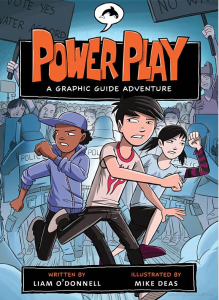As many teachers will tell you, one of the biggest challenges of teaching is keeping students engaged in the stuff they’re supposed to be learning. Students get bored, drift off, the learning ceases and classroom management begins. There are many valid reasons for student disengagement, but one factor has intrigued me for a while: the lack of technology in the classroom. As students’ lives get more wired, schools remain a place cut off from technology, where students feel they have to “power down” in order to participate. As Melanie points out in this quick post, Web2.0 has created Student 2.0 and the teachers of tomorrow (ie me, hopefully) must become Teacher 2.0 (okay, that’s all the point zero stuff for a while, I promise.)
I’m excited about finding ways to use technology appropriately in my classroom. One way this can be done is through video games.
I’ve written about the literacy value in video games in magazines and in this blog . As I’ve progressed in my teacher education, I’ve wondered at how I could use video games in my classroom to tap into both the engagement and literacy factors of good games, while taking into account the realities of teaching 20 – 30 kids six lessons in six different subjects each and every day.
One possible answer, according to David Williamson Shaffer, author of How Computer Games Help Children Learn is “epistemic games.” I just finished Shaffer’s book and I’m excited by what he has to say. What are epistemic games? I’ll let Shaffer’s website do the talking:
Epistemic games are computer games that can help players learn to think like engineers, urban planners, journalists, lawyers, and other innovative professionals, giving them the tools they need to survive in a changing world.
When students play epistemic games, they participate in simulations of a society that they might someday inhabit. These games help them to develop ways of thinking and knowing that are valued in the world, giving them a way to imagine who they might someday become.
Sounds a bit like role-playing, doesn’t it? That’s because in a way it is. Students take on the role of an expert to overcome a challenge. Along the way they not only learn about the subject they’re studying but they learn to explore possibilities, test hypotheses, adjust their thinking and, if working in groups, how to collaborate. These are skills essential to becoming an engaged citizen in a democracy where the rallying cry seems to be standardization (and thus offshoring) of everything (from school tests, to manufacturing and beyond.)
The idea isn’t to use video games exclusively to teach a lesson, but to use it as a tool that fosters learning. Students play the game, explore the possibilities of their role as expert, then build on this knowledge through non-gaming activities, such as writing reports or presenting their findings to the class. The game is merely a tool to engage the students and aid them in constructing their knowledge on the subject.
There are a growing number of examples of teachers using off the shelf, commercial games like Civilization III to teach world history to students, Myst to teach creative writing or World of Warcraft for literacy. While not exactly epistemic in their use, these are all great examples of teachers using games to engage students and transferring this engagement to more traditional school activities (creative writing, history reports, etc.)
As a future teacher, I’m excited to see how others are using technology like games to keep their classroom in step the technological advances beyond the school’s doors. I also look forward to using these technologies in my own classroom in the (hopefully) not too distant future.
For now, however, I’m still trying to figure out how to create a rubric. Baby steps . . .




















